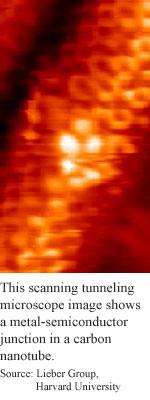
Nanotube kinks control current
By Kimberly Patch, Technology Research NewsIt looks like the nanotube's seemingly perfect structure isn't always so perfect after all.
By taking images of the tiny carbon tubes with a souped-up scanning tunneling microscope, researchers from Harvard University have identified intramolecular defects where every so often two of the nanotubes' usually six-sided carbon rings emerge as a five-sided and a seven-sided pair instead.
These defects, or junctions, which had been proposed theoretically but until now not actually proven, make for mechanically weaker nanotubes, but give them more versatile electrical properties.
Nanotubes form when chicken-wire-like sheets of these ringed carbon molecules roll up to form tubes. Although nanotubes vary in size, a common diameter is one nanometer, which is about the size of a string of 10 carbon atoms.
The irregular junctions are electrically significant because the odd-sided molecules' orbitals -- where it's electrons reside -- line up differently, changing the way the material conducts electricity. Carbon nanotubes can be either metal or semiconducting. Molecules with metal properties readily conduct electricity, while semiconductor molecules offer more resistance to electrical current.
The researchers have found both metal-semiconductor junctions and metal-metal junctions.
A metal-semiconductor junction, with its shift in properties, can be used to guide current, said Charles M. Lieber a chemistry professor at Harvard. "The energy of the electrons in the metal line up with the conduction in the valence bonds in the semiconductor and form a junction which allows current to flow in one direction."
The junctions the researchers found were ideal, meaning the switch from metal to semiconductor properties was abrupt, said Lieber. "The conduction electrons on the metallic regions don't leak into the semiconductor region," he said.
This type of junction, which is common in electrical components like diodes, is a potentially useful building block for making electrical components around four orders of magnitude smaller then the smallest silicon devices built today, which are about 100 by 100 nanometers, said Lieber. "It gives you perhaps as small a metal-semiconductor junction as one could ever hope to make," he said.
The researchers imaged the junctions and measured their electronic properties using a specially rigged ultrahigh vacuum scanning tunneling microscope that works at very low temperatures. They measured the junctions at about five degrees Kelvin. The low temperature slows molecules, making them easier to measure. "Low-temperature gives one enhanced stability and energy resolution, or sensitivity to electronic properties," said Lieber.
The ultrahigh vacuum keeps everything very clean, keeping out particles that could disturb the measurements, he added. "[It] eliminates essentially any gas particles that could form under the surface of the nanotubes."
The measurements suggest that these junctions form randomly in about 10 percent of the nanotubes during their growth, said Lieber.
"It has been well known through topology and chemistry that an intramolecular nanotube junction can be formed. However it has been very difficult to directly confirm this junction structure," said Jie Han, a research scientist in NASA-Ames Research Center's nanotechnology program. Lieber's group is the first to directly confirm that the junctions exist, said Han, whose group previously showed indirect evidence of the junctions.
The next step is to figure out how to control the growth process to produce both defect-free nanotubes for mechanical applications, and introduce in a well-defined manner electrically useful metal-semiconductor defects, said Lieber.
"We have the tools now to characterize the defects, it's a matter of pushing to understand the growth well enough to control it. My feeling is that we should be able to control it," Lieber said.
The junctions also have potential as nanochemistry sites, said Lieber. "There's actually fairly well developed organic chemistry that one could draw on to selectively react at these 5,7 type of structural defects in the nanotubes... to potentially build sensors," he said.
More complicated defects may prove even more useful, said Han. If metal-semiconductor-metal or semiconductor-metal-semiconductor junctions can be found and controlled they would find use in quantum effect devices, Han said. "They may show resonant tunneling and quantum dot behavior, which are key physics features for... nano electric devices."
It is likely to take three to five years to figure out how to control the growth process and use it for mechanical or sensor applications, said Lieber. It will take more like five to ten years before nanotubes can be organized into structures analogous to useful electrical circuitry, he said.
Lieber's research colleagues were Min Ouyang, Jin-Lin Huang and Chin Li Cheung from Harvard. They published the research in the January 5, 2001 issue of Science. The research was funded by the National Science Foundation.
Timeline: 3-5 years, 5-10 years
Funding: Government
TRN Categories: Semiconductors and Materials; Nanotechnology
Story Type: News
Related Elements: Technical paper, "Atomically Resolved Single-Walled Carbon Nanotube Intramolecular Junctions," Science, January 5, 2001.
Advertisements:
January 24, 2001
Page One
Light impresses atoms
Scattered signals boost capacity
Self-configuring robot mimics lifeforms
Nanotube kinks control current
Jellyfish protein proves promising light source

News:
Research News Roundup
Research Watch blog
Features:
View from the High Ground Q&A
How It Works
RSS Feeds:
News
Ad links:
Buy an ad link
| Advertisements:
|
 |
Ad links: Clear History
Buy an ad link
|
TRN
Newswire and Headline Feeds for Web sites
|
© Copyright Technology Research News, LLC 2000-2006. All rights reserved.